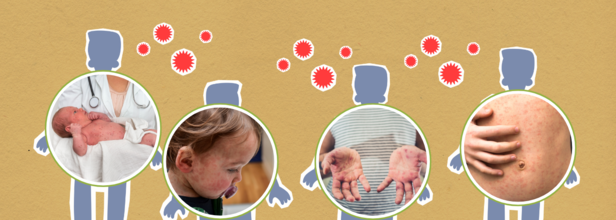- Health Conditions A-Z
- Health & Wellness
- Nutrition
- Fitness
- Health News
- Ayurveda
- Videos
- Medicine A-Z
- Parenting
- Web Stories
World Homeopathy Day 2025: Can Homeopathy Relieve Seasonal Allergies? Here’s What Experts Say

As the seasons change and the air becomes heavy with pollen, millions worldwide prepare themselves for the all-too-familiar symptoms of seasonal allergies—watery eyes, itchy noses, sneezing spasms, and breathing difficulty. While pharmacies stock their shelves with antihistamines and decongestants, an increasing number of individuals are looking to a more natural way- homeopathy.
Often viewed with curiosity and skepticism, homeopathy has gradually gained a devoted following from people looking for relief without the need for drugs. But does it really hold a permanent key to allergies? While we celebrate World Homeopathy Day 2025, we take a deeper look into the science, philosophy, and medical professional opinion driving this age-old school of medicine in order to explore its use in seasonal allergy care.
Seasonal allergies, which are typically caused by pollen, dust mites, pet dander, or temperature change, result from an overreacting immune system response to the usual harmless things in the environment. The allergens mislead the immune system, leading to the release of histamines and other chemicals that trigger a cascade of symptoms including:
- Sneezing and congestion in the nose
- Runny nose and postnasal drip
- Watering, itching, or reddening of eyes
- Skin rashes or irritation
- Difficulty breathing or asthma-like symptoms in a few instances
These symptoms not only feel unpleasant—they can easily interfere with one's everyday life, sleep, and overall work.
Why Individuals Are Looking For All Natural Relief Options for Allergies?
Though traditional medications are quick to bring relief, most of them are associated with side effects like sleepiness, addiction, or constant weakening of the immune system. This has led to the global trend of natural and eco-friendly solutions—with homeopathy being a leader in the pack.
As Dr. Manju Singh, a leading homeopathy professional, puts it, homeopathy is becoming increasingly popular because it is more than symptom relief. "Homeopathy addresses the underlying cause by stimulating the body's own natural healing process. It doesn't cover up symptoms—it reconditions the immune system to react more naturally," she describes.
What is the Homeopathic Approach to Allergy Relief?
Homeopathy is based on the principle of "like cures like"—administering tiny doses of substances that, in larger doses, would produce the very symptoms a patient is suffering from. These extremely diluted remedies seek to stimulate the immune system gently to respond more effectively to allergens.
Some of the most frequently prescribed remedies for allergies are:
Allium cepa: Derived from onions, this is used for symptoms like watery eyes, sneezing, and clear nasal discharge—similar to what one experiences when chopping onions.
Sabadilla: Often recommended for severe sneezing, nasal congestion, and itchiness in the throat.
Natrum muriaticum (Natrum mur): Helpful in managing symptoms tied to weather changes, especially during spring and fall, and works by boosting the body’s defenses.
Dr. Singh adds, "These remedies are specifically matched to an individual's individual symptom pattern. Homeopathy is not an off-the-rack system—it's tailored, which is why it's critical to see a trained practitioner."
Does Homeopathy Really Work?
Clinical data on homeopathy is still controversial within the medical profession, mainly because of the ultra-diluted state of the medicines. But user reviews and increasing clinical interest keep it popular. In nations such as Germany, India, and the UAE, homeopathy is an accepted system of medicine, and patients often exhibit better tolerance to allergens and fewer flare-ups following regular treatment.
Numerous patients turn to us having exhausted all else. They have grown weary of medication that gets results for the moment but produces no lasting solutions," Dr. Singh says. "In several such instances, within a matter of months using homeopathic solutions, we witness lowered frequency and severity of the condition."
Is It Safe? What to Know Before Starting
One of the most attractive features of homeopathy is its low risk profile. The medicines are so diluted that they hardly produce side effects, and hence they can be used by children, elderly, and even pregnant women, as long as they are used under medical supervision.
Some people may even have a short-lived worsening of symptoms, referred to as a healing crisis, which practitioners see as an indication that the body is reacting to treatment. "This is an inevitable stage and usually goes away in no time," assures Dr. Singh.
Still, it's important not to self-diagnose or self-medicate, particularly when dealing with chronic allergies. A trained homeopath takes into account an array of physical, emotional, and environmental variables before suggesting a remedy.
In a time when lifestyle disorders and immune sensitivities are on the increase, individuals are looking for treatment philosophies that support long-term wellness objectives. Homeopathy, with its focus on individualization, natural healing, and immune strength, presents a strong alternative for individuals who wish to escape the side effects of steroids or lifetime reliance on antihistamines.
Dr. Singh stresses, "It's not a matter of either/or. Many of our patients incorporate homeopathy into their overall health regimens—along with dietary changes, stress reduction, and conventional care where appropriate."
So, can homeopathy cure seasonal allergies? For many, the answer is yes—but it's not a magic bullet. The true strength of homeopathy is its subtle, cumulative action, allowing the body to become less reactive over time. As word spreads and more people come forward with their success stories, homeopathy is moving into the limelight—not as a replacement, but as a trusted ally in the quest for holistic health.
If you’re considering homeopathy for allergy relief, consult a licensed practitioner and stay consistent. Relief may not come overnight—but for many, it’s a breath of fresh air in more ways than one.
Dr Manju Singh senior homeopathic doctor and expert, senior homeopathic medical officer at SBL Global in India
World Misophonia Awareness Day 2025: Why Misophonia Makes Everyday Sounds Feel Like An Attack—Here’s What It Does To The Brain

Credits: Health and me
You're at the dinner table and someone slurps soup, another begins tapping a pen, and your heart begins racing, your muscles lock up, and you're filled with fury you can't explain. If this sounds familiar, you're not being "too sensitive." You may be one of millions dealing with misophonia, a little-understood sensory disorder finally receiving long-overdue notice.
On July 9, World Misophonia Awareness Day, experts and advocacy groups are urging for global recognition of this condition that impacts almost 1 in 5 adults, but too often remains misunderstood or undiagnosed. Initiated by non-profit soQuiet, the day is dedicated to advancing discussion, research, and support for those whose lives are deeply affected by what the rest of us tune out—usual, ordinary sounds.
What Is Misophonia?
Misophonia, literally "sound hatred," is more than not liking noise. It's an intense, automatic emotional and physical response to certain sounds, usually created by someone else. Chew, sniffle, heavy breathing, throat clearing, even pen clicking.
These stimuli trigger strong reactions in individuals with misophonia, from annoyance, stress, and revulsion to outright panic or fury. For some, it's a single stimulus. For others, it's multiple. The psychological weight can be overwhelming, so that everyday encounters such as dining at a restaurant or working in an open office become a daily war.
And though most people write it off as being irritable or melodramatic, the science disagrees.
An increasing amount of research is revealing what's actually going on in the brains of individuals with misophonia. A 2022 study published in Frontiers in Neuroscience indicates that misophonia is potentially associated with a specific "neural signature"—unique brain pathways that are more active in perceiving sound and emotion.
In misophonics, increased interconnectivity between the sound-processing auditory cortex and the emotion-regulating limbic system may be what makes some sounds ring alarm bells. It's a brain in overdrive, responding in the same way to a throat clear or chewing noise as it would to a bodily threat.
A reflexive fight-or-flight response—hands sweat, heart throbs, and logical thinking yields to a frantic need to flee or strike out.
Why Misophonia Is Unheard And Misunderstood?
Perhaps one of the most infuriating things for people with misophonia is that others just don't get it. It doesn't help that they are invisible and their reactions are usually termed overreactions, even rudeness.
Worse still, it has the potential to overlap with or be confused with other mental illnesses such as OCD, anxiety, PTSD, or even autism spectrum disorders. That is why diagnosis becomes complicated and many suffer silently, particularly older people who might have spent decades without ever hearing the term "misophonia."
The stigma may result in isolation, strain on relationships, and depression, particularly when individuals are stuck in environments where they cannot escape to be safe from trigger sounds—such as school, work, or home mealtime.
Misophonia is not just about being uncomfortable—it's about survivability. Most with the condition report avoiding parties, leaving jobs, or having trouble with day-to-day activities just to prevent exposure to triggers. Picture wearing noise-canceling headphones just to get through your workplace. Or having every meal in solitude, because even the sound of eating is too much. In a world that's getting noisier, adaptation is a full-time profession.
How Misophonia Affects the Brain?
Misophonia's not so much about what you're hearing—it's about how your brain interprets that sound. New research indicates that individuals with misophonia exhibit heightened activity and connectivity within brain areas that handle sound processing, emotional control, and the body's defense mechanism.
One of the most important regions engaged is the anterior insular cortex, which assists you in assessing the emotional meaning of sensory input. In misophonia, this region seems to hyperreact, sending messages that something harmless—such as someone chewing—is threatening. This activates the limbic system, which controls emotion and survival reactions, placing the individual in a fight-or-flight state very quickly.
Imagine it like a smoke alarm blaring at burnt toast like it is a raging house fire. That exaggeration is what makes misophonia so debilitating. A person with misophonia has a complete body stress response when they hear a trigger sound, even though rationally, they know the sound is not harmful.
Brain imaging studies suggest this is not about overreacting by choice—it’s a neurological mismatch, where emotional and auditory systems are too tightly wired together. That’s why even brief exposure to trigger sounds can feel unbearable and linger long after the sound stops.
Common Trigger Sounds of Misophonia
Misophonia triggers are different for different people but most follow predictable patterns. They're not loud or startling noises—they're typically repetitive, mundane sounds easily tuned out by other people but for the misophonic person, which can trigger an almost immediate adrenaline rush of anger, panic, or disgust. The following are the most typical categories of trigger sounds:
Drinking and eating noises: Smacking lips, slurping, chewing, gulping, crunching, and loud swallowing are the worst. Chewing gum is a very frequent offender.
Sounds associated with breathing: Sniffling, heavy breathing, nose blowing, or snoring are common culprits. Even a faint wheeze can be offending for some.
Sounds of the mouth and throat: Throat clearing, coughing, yawning, or audible kissing sounds.
Repetitive sounds of activity: Tapping on the pen or feet, mouse clicking, typing, drumming fingers, or even paper or plastic bag rustling.
Environmental and ambient sounds: Ticking clock, ringing telephone, dripping water, or sounds of animals such as barking.
Surprisingly, several individuals comment on how the proximity or origin of the noise is important. A TV chewing noise might be mildly annoying—but if it's coming from someone sitting directly next to them, the response can be volcanic. This serves to illustrate that misophonia is not about the sound type or volume but also relationship, context, and physical proximity.
Knowing these triggers can inform treatment and coping mechanisms, particularly when seeing therapists and learning to recognize patterns and decrease emotional reactivity over time.
Is Misphonia Treatable?
Misophonia is finally being studied, understood, and treated. Cognitive Behavioral Therapy (CBT) is showing promising results. A 2020 study published in Depression and Anxiety found that more than a third of patients undergoing CBT saw a meaningful reduction in misophonia symptoms—and these improvements held up a year later.
CBT involves finding individual noise triggers and reframing the emotional response to them. It's training the brain to break the anxiety or anger spiral, not allow it to get the best of you. In extreme cases, therapy is also paired with anti-anxiety medication to decrease reactivity, particularly when CBT alone doesn't work. Other coping strategies are:
- Wearing noise-canceling headphones
- Using white noise machines or soothing background music
- Deep breathing or muscle relaxation exercises
Why is Family and Social Support Important?
For individuals with misophonia, having family members know what the condition is and what it's like makes a huge difference. Family members tend to unwittingly become trigger points—chewing at the dinner table, throat clearing, playing music out loud.
Dismissal and blame only exacerbate the emotional toll. Specialists maintain that education and compassion are essential. Accepting that the response is involuntary—and not a personal affront—is critical. Offering professional assistance and using supportive measures in the home can assist in creating safe, respectful spaces for those affected.
World Misophonia Awareness Day isn't only for patients—it's for everyone. By recognizing that some sensory stimuli can be triggering, offices, schools, and public places can start to make changes that are inclusive.
Misophonia isn't a trait, it's a real, life-changing condition that's worthy of attention and understanding. As the research expands and the stories get out there, we get closer to a world where individuals with misophonia don't merely exist—but thrive.
UK Health Officials Issue A Public Warning And Safety Guidelines Against These Bugs That Cause Lyme Disease

(Credit-Canva)
As an unexpected wave of heat hits the UK, many people have been concerned regarding not just heat-illnesses, but also other issues that arise mostly in the summer season.
The UK Health Security Agency (UKHSA) has issued a public warning against a small, almost invisible threat that could send you to the hospital. Taking simple steps can help you avoid these bugs that could leave you with flu-like symptoms lasting for weeks.
The Hidden Danger: Ticks
Ticks are small bugs often found in woods, grassy areas, and moorlands. The reason why the volume of these bugs is more prevalent in these grassy areas is because it is easier to find and feed off other creatures there. These bugs are known to spread Lyme disease, a bacterial infection. You get it when a tick bites you and feeds on your blood, which can lead to flu-like symptoms. Not all ticks carry Lyme disease, though. It's usually easier to treat if caught early, but if it goes unnoticed, problems can worsen, causing joint pain, nerve issues, and memory problems.
Lyme Disease Treatment
The chances of getting sick are fairly low, as not all ticks carry the bacteria that cause Lyme disease. If you've been bitten, keep a close eye on the bite area for symptoms, especially the well-known "bullseye" rash. This rash can appear up to three months after a bite, but usually shows up within one to four weeks.
If a doctor thinks you might have Lyme disease, they'll prescribe antibiotics. The type you get depends on your symptoms, and you might need to take them for up to 28 days. It's very important to finish the entire course, even if you start feeling better. For severe symptoms, you might be sent to a hospital specialist to receive antibiotics directly into a vein.
A small number of people who are treated for Lyme disease continue to have symptoms like tiredness, aches, and low energy for years. These symptoms are often compared to conditions like fibromyalgia and chronic fatigue syndrome.
What to Do If You're Bitten
Tick bites might not hurt at first because ticks put a numbing substance into your skin, so you might not even notice you've been bitten. If you do find a tick, it's important to take it out the right way: use fine-tipped tweezers or a special tick-removal tool, grasp the tick as close to your skin as you can, and pull it slowly upwards without squeezing it. Never try to pull it out with your fingers, as this can leave part of the tick in your skin and cause an infection. After removing the tick, clean the bite area with antiseptic or soap and water.
Simple Prevention Tips
Health officials recently shared advice on how to protect yourself from these tiny parasites. They suggest simple actions are best to prevent tick bites:
- Regular checks are your best defense. While you're outside, brush off any ticks you spot right away.
- Do another check when you get home. Focus on exposed skin and any clothes where these bugs might be clinging.
- Don't forget to check children and pets, as they can't check themselves.
- Use an insect repellent that specifically prevents ticks.
- Wear long sleeves and long trousers when outdoors to reduce direct skin contact.
- When possible, stick to clearly marked paths and avoid brushing against plants where ticks might be hiding.
Even After The Elimination Of Measles In 2000, Why Is US Struggling With It Today?

Credits: Canva
The United States is facing its worst measles outbreak in 25 years, with more than 1,270 confirmed cases reported so far this year—surpassing the previous high of 1,274 cases in 2019. The data, compiled by Johns Hopkins University, has raised alarms among health officials, who believe the actual number of infections may be even higher due to underreporting.
Tragically, three people have died from the virus this year—two children in Texas and one adult in New Mexico. All of them were unvaccinated.
“This move will further fuel the spread of vaccine-preventable illnesses,” said Dr. Bruce A. Scott, president of the American Medical Association, referencing ongoing declines in vaccination rates and policy shifts that threaten public health.
From Elimination to Outbreak
Measles is one of the most contagious diseases known and was declared eliminated in the United States in 2000, thanks to the widespread use of the MMR (measles, mumps, rubella) vaccine. However, current outbreaks suggest a reversal of that progress.
The largest outbreak this year began in January in Gaines County, West Texas—a region with one of the lowest vaccination rates in the state. So far, that outbreak alone has led to over 750 confirmed cases and has spread to neighboring areas in New Mexico and Oklahoma, with possible links to Kansas.
Shockingly, nearly one in four kindergartners in Gaines County did not receive their required MMR vaccine during the 2024–25 school year.
Spread Through Travel and Everyday Contact
Measles spreads easily through airborne droplets when an infected person coughs, sneezes, or talks. The virus can also live on surfaces like doorknobs for several hours, making it especially hard to contain.
Air travel has further complicated containment efforts. In Colorado, an out-of-state visitor unknowingly spread the virus while contagious, leading to multiple cases—including individuals who were only at the airport at the same time.
According to the CDC, nearly 1 in 8 people infected this year required hospitalization, and about 30% of all cases have been in children under the age of five. Most of these children were unvaccinated.
The Role of Vaccination
The MMR vaccine remains the most effective tool against measles. One dose offers 93% protection, while two doses provide 97% protection.
In response to the crisis, some states have taken emergency steps to protect infants. Several have lowered the age for the first MMR shot from 12 months to 6 months. The results have been encouraging—early vaccination rates among 6-month-olds in Texas are now eight times higher than in 2019.
New Mexico has also seen a significant rise in vaccination, and both states are working hard to protect their most vulnerable populations.
Still, nationwide vaccination rates remain below targets. The U.S. aims for 95% of kindergartners to receive both doses of the MMR vaccine, but this benchmark has been missed for the past four years. In the 2023–24 school year alone, over 125,000 kindergartners lacked at least one required vaccine.
A Shifting Public Health Landscape
Public health experts are concerned that growing distrust in vaccines and leadership changes at the federal level may further undermine efforts to control the disease.
As of now, the CDC does not have a permanent director in place, and U.S. Health and Human Services Secretary Robert F. Kennedy Jr.—a long-time vaccine skeptic—has made controversial decisions. Though he recently expressed support for vaccines, his previous statements and the removal of key expert panels have left public health officials worried.
If outbreaks linked to the Texas region continue into 2026, the U.S. risks losing its measles elimination status. Experts say rebuilding public trust in vaccines and boosting routine childhood immunizations must become a national priority—before the disease becomes even harder to contain.
© 2024 Bennett, Coleman & Company Limited

